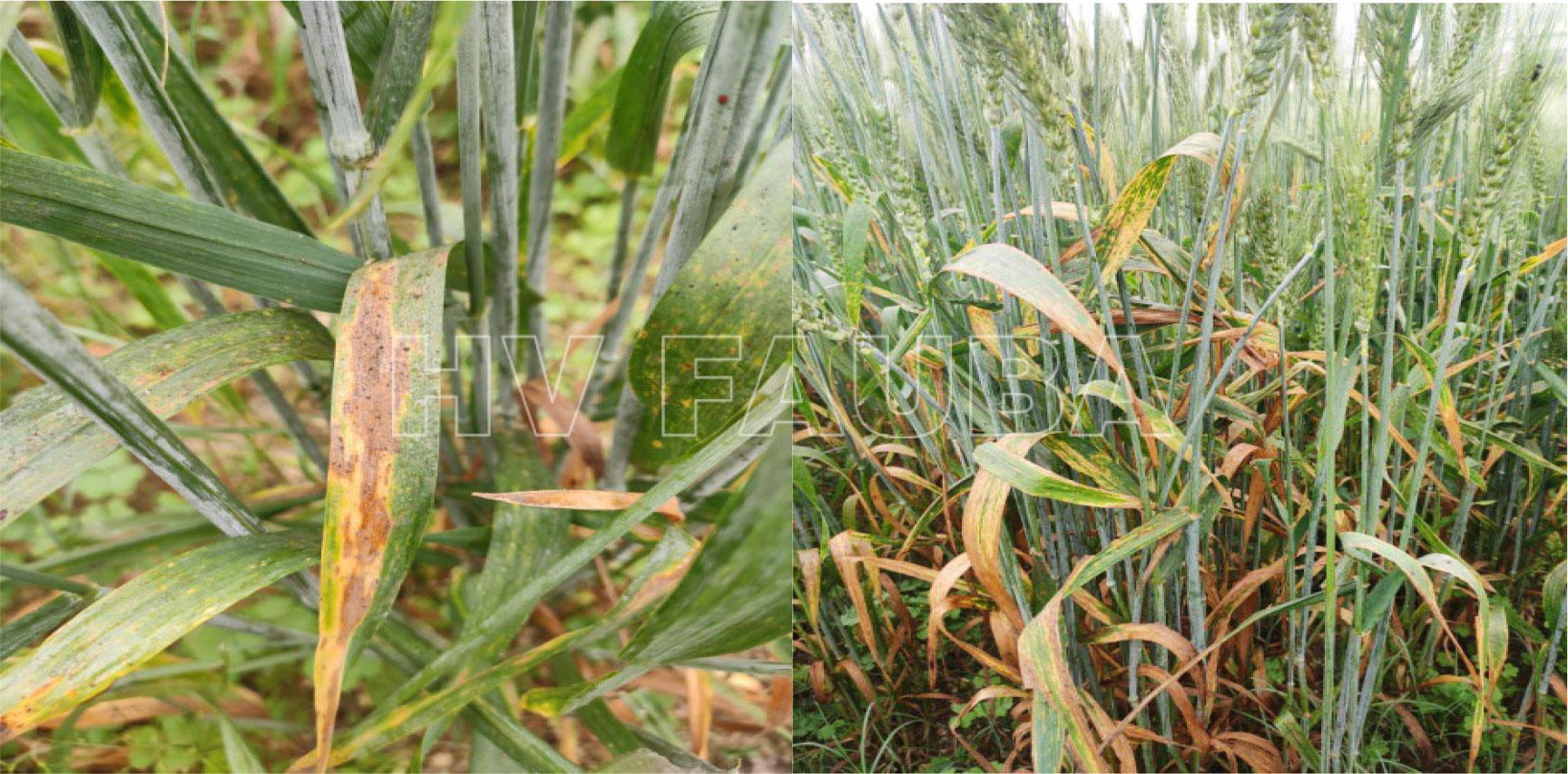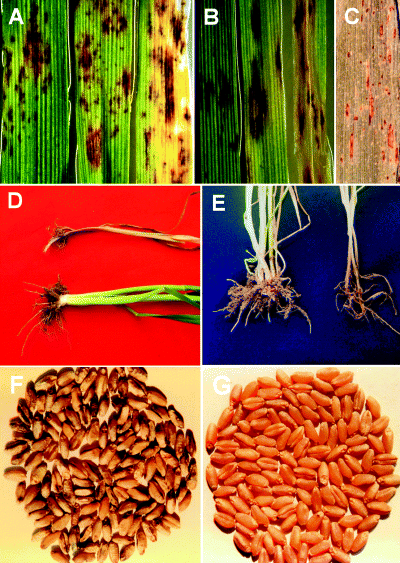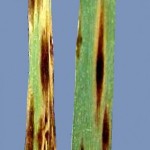.
Condición fitosanitaria: Presente
Grupo de cultivos: Cereales
Rango de hospedantes: Los hospedantes incluyen cebada, trigo, arroz, centeno y especies de malezas y pastos (Jones y Clifford, 1983). El trigo y la cebada son los hospedantes económicamente más importantes (Murray et al., 1998).
Especie hospedante: Trigo (Triticum aestivum)
Epidemiología: policíclica, subaguda.
Etiología: Hongo. Necrotrófico
Agente causal: Bipolaris sorokiniana (Sorokin) Shoemaker, 1959 (Syn. Helminthosporium sativum H. sorokiniana) (teleomorfo Cochliobolus sativus)
Taxonomía: Eukaryota > Fungi > Dikarya > Ascomycota > Pezizomycotina > Dothideomycetes > Pleosporales > Pleosporaceae > Bipolaris
.
.
Antecedentes
En nuestro país las manchas foliares causadas por B. sorokiniana presentan menor importancia que las D. tritici-repentis y S tritici. Sin embargo, en las últimas campañas se observó un mayor crecimiento significativo de esta enfermedad tanto en tanto en cultivos de trigo como en sus semillas. La incidencia de esta enfermedad es mayor en regiones más cálidas. En regiones más cálidas su incidencia es mayor.
.
- Autor: Roy et al., 2023
.
Síntomas y signos
Produce lesiones de color marrón oscuro en coleoptiles, plúmulas, hojas y vainas. Algunas veces puede observarse el centro de la lesión un poco más claro.
.
.
- Enfermedades causadas por Bipolaris sorokiniana. El patógeno causa manchas en las hojas primarias de cebada (A), trigo (B) y hojas bandera de trigo (C). Las lesiones necróticas son de color claro en la cebada en comparación con las lesiones más oscuras en el trigo. Las hojas de cebada desarrollan más clorosis en comparación con el trigo. La pudrición común de la raíz (D), la pudrición de la corona (E) y el punto negro (F) (compárese con los granos sanos en G) ocurren típicamente en el trigo. Se encuentran síntomas similares en la cebada (no se muestra). Autor: Kumar et al., 2002.
.
.
Condiciones predisponentes
para el establecimiento y dispersión de la enfermedad se requieren períodos prolongados con alta humedad relativa y mojado foliar de al menos 15 horas, neblinas, frecuentes lloviznas y temperaturas entre 20 a 25 ºC.
.
Manejo
Rotación de cultivos, uso de semilla sana o tratada eficientemente, siembra de cultivares tolerantes y aplicación de fungicidas.
.
.
.
Bibliografía
Aboukhaddour R, Hafez Abdel-Fattah M, McDonald M, et al. (2023) A revised nomenclature for ToxA haplotypes across multiple fungal species. Phytopathology. doi: 10.1094/PHYTO-01-23-0017-SC
Al-Sadi AM (2021) Bipolaris sorokiniana-Induced Black Point, Common Root Rot, and Spot Blotch Diseases of Wheat: A Review. Front. Cell. Infect. Microbiol. 11: 584899. doi: 10.3389/fcimb.2021.584899
Asad S, Iftikhar S, Munir A, Ahmad I (2009) Characterization of Bipolaris sorokiniana isolated from different agro-ecological zones of wheat production in Pakistan. Pak. J. Bot., 41(1): 301-308.
Ayana GT, Ali S, Sidhu JS, Gonzalez Hernandez JL, Turnipseed B and Sehgal SK (2018) Genome-Wide Association Study for Spot Blotch Resistance in Hard Winter Wheat. Front. Plant Sci. 9:926. doi: 10.3389/fpls.2018.00926
MA (2021) Sensitivity of Bipolaris sorokiniana to strobilurin, triazole, and carboxamide premixes. Archives of Phytopathology and Plant Protection 54: 1764-1777. doi: 10.1080/03235408.2021.1938920
Duczek LJ, Sutherland KA, Reed SL, Bailey KL, Lafond GP (1999) Survival of leaf spot pathogens on crop residues of wheat and barley in Saskatchewan. Canadian Journal of Plant Pathology 21: 165-173. doi: 10.1080/07060669909501208
Duveiller E, García Altamirano I (2000) Pathogenicity of Bipolaris sorokiniana isolates from wheat roots, leaves and grains in Mexico. Plant Pathology 49: 235-242. doi: 10.1046/j.1365-3059.2000.00443.x
Gupta PK, Chand R, Vasistha NK, et al. (2018) Spot blotch disease of wheat: the current status of research on genetics and breeding. Plant Pathology 67: 508-531. doi: 10.1111/ppa.12781
Holz TM, Dorneles KR, Brunetto AE (2022) Effect of silicon and fungicide on photosynthetic responses in barley leaves challenged by Bipolaris sorokiniana. Physiological and Molecular Plant Pathology 120: 101849. doi: 10.1016/j.pmpp.2022.101849
Jones DG, Clifford BC (1983) Cereal diseases, their pathology and control. John Wiley & Sons Ltd.
Kumar J, Schäfer P, Hückelhoven R, et al. (2002) Bipolaris sorokiniana, a cereal pathogen of global concern: cytological and molecular approaches towards better control. Molecular Plant Pathology 3: 185-195. doi: 10.1046/j.1364-3703.2002.00120.x
McDonald MC, Ahren D, Simpfendorfer S, et al. (2017) The discovery of the virulence gene ToxA in the wheat and barley pathogen Bipolaris sorokiniana. Molecular Plant Pathology (in press). doi: 10.1111/mpp.12535
Murray TD, Parry DW, Cattlin ND (1998) A color handbook of diseases of small grain cereal crops. Iowa State University Press, Ames, Iowa.
Navathe S, Pandey AK, Sharma S, et al. (2022) New Genomic Regions Identified for Resistance to Spot Blotch and Terminal Heat Stress in an Interspecific Population of Triticum aestivum and T. spelta. Plants 11(21): 2987. doi: 10.3390/plants11212987
Prahl KC, Klink H, Hasler M, et al. (2022) Can Decision Support Systems Help Improve the Sustainable Use of Fungicides in Wheat? Sustainability 14(23): 15599. doi: 10.3390/su142315599
Roy C, He X, Gahtyari NC, et al. (2023) Managing spot blotch disease in wheat: Conventional to molecular aspects. Front. Plant Sci. 14: 1098648. doi: 10.3389/fpls.2023.1098648
Sharma S, Sahu R, Navathe S, Mishra VK, Chand R, Singh PK, Joshi AK and Pandey SP (2018) Natural Variation in Elicitation of Defense-Signaling Associates to Field Resistance Against the Spot Blotch Disease in Bread Wheat (Triticum aestivum L.). Frontiers in Plant Science 9:636. doi: 10.3389/fpls.2018.00636
Wei X, Xu Z, Zhang N, Yang W, Liu D, Ma L (2021) Synergistic Action of Commercially Available Fungicides for Protecting Wheat from Common Root Rot Caused by Bipolaris sorokiniana in China. Plant Disease 105(3): 667-674. doi: 10.1094/PDIS-03-20-0627-RE
Zhao W, Chi YK, Ye MD, Wang T, Xu AM, Qi RD (2021) Development and Application of Recombinase Polymerase Amplification Assay for Detection of Bipolaris sorokiniana. Crop Protection 105619. doi: 10.1016/j.cropro.2021.105619


